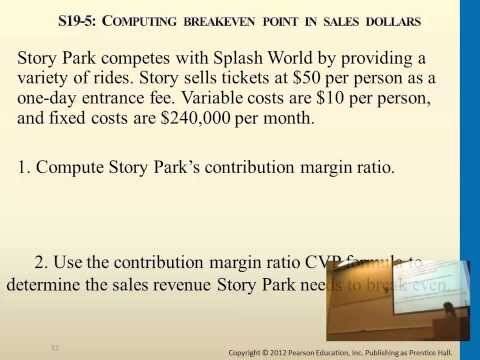
It is the interest earned on both the initial sum combined with interest earned on already accrued returns. Say in our previous example that we earned interest semiannually rather than annually. Because n represents the number of compounding periods, and we are compounding semiannually for five years, there will be 10 compounding periods. We multiply five years by a compounding frequency of two (twice per year) to arrive at the number of compounding periods. Now we also can’t use the same rate, because if we have n as 10, and we used our annual rate, then this would be compounding annually for ten years. In order to adjust the rate, we must divide it by 2, since we are now earning 2% per period rather than 4%.
- All that happens is that in that three-year period, each deposit accrues interest for one more period.
- Simply enter your initial investment (principal amount), interest rate, compound frequency and the amount of time you’re aiming to save or invest for.
- However, in the daily compounding calculator, interest compounds daily AND unpaid interest is added to the principal balance (like a credit card).
- It did not matter whether one measured the intervals in years, months, or any other unit of measurement.
- Now, yes, this is a lot of steps, but thankfully we have our formula to calculate that same value in just a few basic algebraic steps.
But over a long time horizon, history shows that a diversified growth portfolio can return an average of 6% annually. Investment returns are typically shown at an annual rate of return. With savings and investments, interest can be compounded at either the start or the end of the compounding period. If
additional deposits or withdrawals are included in your calculation, our calculator gives you the option to include them at either the start
or end of each period.
Gave up daily coffee purchases.
When saving and investing, this means that your wealth grows by earning investment returns on your initial balance and then reinvesting the returns. However, when you have debt, compound interest can work against you. The amount due increases as the interest grows on top of both the initial amount borrowed and accrued interest. Your annual interest rate compounds faster than any bank account, including savings, money market accounts, and CDs. There are many different places you can save your money with various compounding periods.
Let’s break down the interest compounding by year with a more realistic example scenario. We’ll say you have $10,000 in a savings account earning
5% interest per year, with annual compounding. We’ll assume you intend to leave the investment untouched for 20 years. If your initial investment is $5,000 with a 0.5% daily interest rate, your interest after the first day will be $25.
When interest compounding takes place, the effective annual rate becomes higher than the nominal annual interest rate. The more times the
interest is compounded within the year, the higher the effective annual interest rate will be. The daily reinvest rate is the percentage figure that you wish to keep in the investment for future days of compounding. As an example, you may wish to only reinvest 80% of the daily interest you’re receiving
back into the investment and withdraw the other 20% in cash. See how much daily interest/earnings you might receive on your investment over a fixed number of days, months and years.
- Certificates of deposit (CDs), money market accounts, and savings accounts may pay compound interest on a daily or monthly basis.
- To calculate the ending balance with ongoing contributions (c), we add a term that calculates the value of ongoing contributions to the principal balance.
- Simply divide the number 72 by the annual rate of return to determine how many years it will take to double.
- This book teaches you how retirement planning really works before it’s too late.
He understood that having more compounding periods within a specified finite period led to faster growth of the principal. It did not matter whether one measured the intervals in years, months, or any other unit of measurement. Each additional period generated higher returns for the lender. Bernoulli also discerned that this sequence eventually approached a limit, e, which describes the relationship between the plateau and the interest rate when compounding. Consistent investing over a long period of time can be an effective strategy to accumulate wealth.
Find an investing pro who can guide you.
Let’s say you have $1000 to invest, and you can leave that amount for 5 years. The financial institution where you deposit the money offers you a 10% interest rate, which will be compounded daily. For your convenience current savings rates for high-interest savings, money market accounts and CDs are published below the calculator. With the compound interest calculator, you can switch the view to see a comprehensive breakdown in different formats. The initial bar chart showcases how compound interest grows over time on top of your principal amount.

Use our interest calculator to calculate the possible growth of your savings and investments over time. You can include regular deposits and withdrawals in your calculation. The present value is simply the amount of money that will be invested, i is the interest rate for each time interval, and n is the number of compounding intervals. The formula can be used when compounding annually, monthly, or at whatever time interval over which you wish to compound. The only thing you must remember is that the interest rate must match your time period. If you are compounding daily, for example, then be sure that you are working with a daily interest rate, or if you are compounding monthly, be sure that you are working with a monthly interest rate.
Daily Compound Interest
In the modern market one has to go out on the risk curve to obtain returns, which was the entire point of quantitative easing. See how much growth you can expect in your savings accounts by plugging a few numbers into the compound interest calculator. Compound interest, on the other hand, puts that $10 in interest to work to continue to earn more money.

We encourage you to seek personalized advice from qualified professionals regarding all personal finance issues. No matter how old you are or how much investing experience you have, the HoweyTrade videos, worksheet, and quiz can provide you tips for protecting your money. Learn how to use a vision board to motivate yourself to save and invest for your financial goals.
Through the SmartVestor program, you can connect with up to five of them in your area for free and then decide who you want to work with. Sign up to get updates from MoneyGeek including how to overcome your financial headwinds, hack your finances, and build wealth. The longer you take to pay off your debts, the higher your compounding interest will be, and you’ll end up paying back much more in the end. If compounding monthly, $1,489.85 is the total compound interest value after five years. Interest Earned – How much interest was earned over the number of years to grow.
Saved an extra $100 per month.
With compound interest, the interest you have earned over a period of time is calculated
and then credited back to your starting account balance. In the next compound period, interest is calculated on the total of the principal plus the
previously-accumulated interest. Banks benefit from compound interest lending money and reinvesting interest received into additional loans.
Between 1970 & 2016 the S&P 500 Index returned an average annual return of 10.31% while REITs returned an average of 11.42%. Since inception in 1927 the S&P has returned about 10% annually. About half of historical returns were driven by dividends, while the other half was driven by capital appreciation. custom carbonless ncr invoice books Is your bank offering competitive rates which beat inflation and taxes? If not, you may be able to earn a better rate & make your money work harder by shopping around. You can look at your loan or credit card disclaimer to figure out if your interest is being compounded and at what rate.
Compound interest occurs when interest is added to the original deposit – or principal – which results in interest earning interest. Financial institutions often offer compound interest on deposits, compounding on a regular basis – usually monthly or annually. Compound interest causes investments to grow faster, but also causes debt to grow faster. It’s important to understand what type of interest that you are earning on investments or accruing on debt so that you can properly plan for future earnings and payments. As you can see, the more frequent the compounding, the more interest will be earned. Therefore, daily compounding yields more interest than monthly, quarterly, or annually compounded interest.
It’s a great first step toward protecting your money and it only takes a few seconds. Learn more about an investment professional’s background registration status, and more. Determine how much your money can grow using the power of compound interest. The Annuity Expert is an online insurance agency servicing consumers across the United States.
If you want to know how much interest your investment will earn, our compound interest calculator can help. Contact us today to request a service quote or learn more about our products and solutions. Compound interest formulas are the interest rate you earn on your money during a compounding period in a financial institution or insurance company savings account. When there’s compound interest, the money you earn each year is added to the money you already have. So, instead of just growing, the accumulated interest grows at an increasing rate which helps save for retirement or invest in stocks.